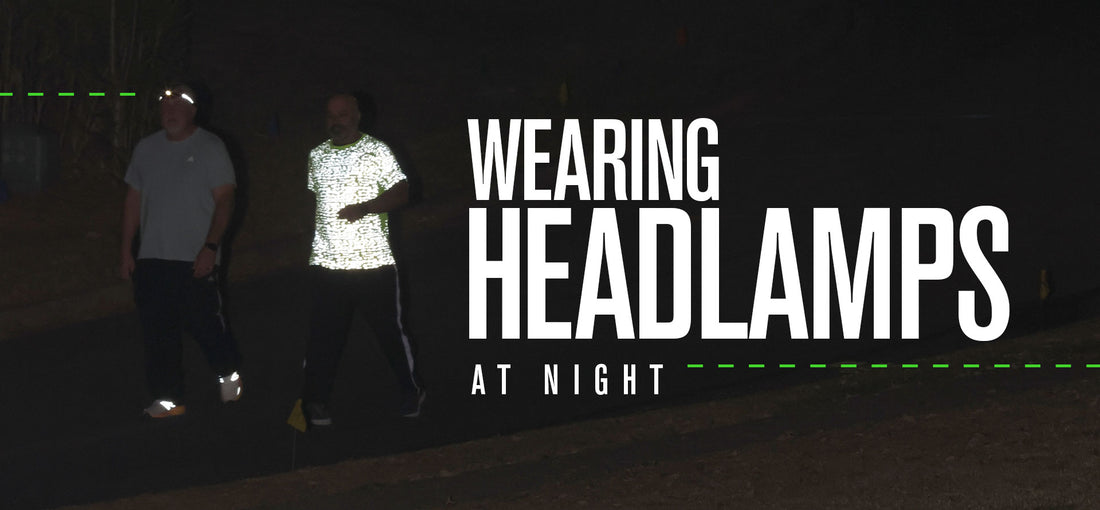Headlamps for Walking At Night: Are They Safe?
A recent article from the New York Times asked the question “Why Are So Many American Pedestrians Dying at Night?” The story points out that in 2021, more than 7,300 pedestrians died in America – with 76% of those deaths occurring between sundown and sunrise, according to the Federal Highway Administration.
Those startling numbers should provide a sobering reminder that it’s critical to take precautions if you’re planning to run or walk after dark or before the sun comes up. To help ensure their safety, many people wear headlamps to help with illumination when they’re getting out for a nighttime jog or stroll. But are headlamps for walking at night really effective? That’s what we’ll explore in this blog.
Headlamps for Walking At Night
Using a headlamp when you’re exercising outside at night seems like a logical choice. Since it attaches to your head, a head torch allows you to keep your hands free, meaning there’s nothing to affect your balance – a big advantage if you’re coming off the trail to your car after night hiking – and the light will always shine in the direction you’re looking. Many of them also offer adjustable brightness and beam angle settings, which can help you be more visible to drivers and cyclists.
However, using a headlamp alone isn’t really sufficient for keeping you safe when you’re out walking at night or on a night hike. Let’s get into the reasons for that.
Why Headlamps Are Not The Best Choice For Night Walking
While we won’t recommend you NOT wear a headlamp when you’re walking or running at night – they can be useful in certain situations – it’s important to be aware of some of the primary drawbacks when you’re making decisions about how to keep yourself safe.
Pedestrian Safety: Blinding Drivers
Wearing a headlamp while exercising at night can pose a safety hazard by potentially temporarily blinding others – including drivers. The concentrated beam of light emitted from the headlamp may dazzle oncoming traffic, especially if it’s on the brightest setting or improperly adjusted. This glare can momentarily compromise their vision, leading to a higher risk of accidents. This is especially true when drivers are navigating unfamiliar roads and not expecting to encounter pedestrians.
No Visibility From Your Sides
Headlamps for night walking are great for illuminating what’s right in front of you, but they offer little protection when it comes to others being able to see you from the sides or from behind. So, while oncoming traffic might be able to identify you more easily due to the beam of light coming from your head, drivers coming from your side or rear could have trouble seeing you if you’re not taking other safety precautions like wearing reflective clothing.
Limited Visibility in Weather Conditions
Most people who are avid walkers or runners don’t take days off just because the weather isn’t great. While this is certainly admirable, if you’re relying on a headlamp to keep you safe in inclement conditions you might want to think twice.
Things like fog, rain, and snow can seriously hamper the effectiveness of headlamps, as those elements scatter and refract light. In foggy conditions, light can bounce off water droplets, creating a disorienting glare, while raindrops and snowflakes tend to refract and diffuse light. This means the light from your headlamp might only be visible from a short distance – even at maximum brightness – and that could make the difference between staying safe and having a serious accident.
Can The High Lumen Beam of Light From A Headlamp Be Distracting?
Lumens are a measure of how much light you get from a bulb or bulbs. Many headlamps offer “high-lumen beams” which seems great for protection – but it can actually be a negative. A headlamp with an excessively bright output can cause discomfort and temporary blindness if a driver, cyclist, or another pedestrian. That’s a distraction that can compromise the safety of both the person wearing the headlamp and those in its vicinity. If you do insist on wearing a headlamp, make sure to adjust the brightness according to the surroundings (often employing a low setting) and to angle it downward to minimize the risk.
Alternatives To Headlamps for Walking At Night
Now that we’ve looked at some of the drawbacks of wearing a headlamp for walking or running at night, let’s talk about some alternatives that can be more effective at keeping you safe.
Reflective Walking and Running Shirts
The very best way to protect yourself when you’re walking or running at night is to wear some kind of reflective and highly visible clothing. Despite what many people believe, wearing a white shirt won’t keep you safe when you’re out at night.
WildSpark apparel offers great options when it comes to making sure you’re visible even after the sun has set. Safe reflective shirts for running at night that are comfortable to wear like this one ensure that the most prominent part of your body – your torso – remains highly visible in the dark, especially to any vehicle traffic you may encounter.
Reflective Running Gear
In addition to reflective shirts, there is a wide variety of other reflective running gear available to help keep you visible in low-light situations. Consider investing in a pair of reflective shorts and a reflective jacket for cooler weather. If you want to stay extra-safe, you can even consider purchasing a reflective hat, belt, and backpack!
Check out more of our best reflective running gear of 2023 here.
High Visibility Vests
One item that many people forget as an option for nighttime exercise safety is a reflective running vest. These vests incorporate reflective materials that bounce back light from external sources like headlights, making them a simple yet effective accessory for anyone walking or running on roads or paths in the dark. They are usually lightweight and breathable to ensure comfort during physical activities and most options don’t cost a fortune.
What Are The Best Headlamps for Walking At Night?
Now that we’ve established that headlamps are best used in addition to other safety gear like reflective clothing when walking or running at night, let’s take a look at some of the best headlamp options.
Black Diamond Headlamps
Black Diamond headlamps like this Storm 400 model for sale at Amazon are an excellent choice for nighttime walking or running. The versatile design allows for customizable flashlight brightness levels and beam angles, adapting to various conditions and preserving battery life. Black Diamond headlamps are durable and weather-resistant, and their lightweight and ergonomic design – with comfortable straps – ensures comfort during extended use. Easy-to-use controls, long battery life, and reliable performance makes these headlamps a smart choice at a good price for those seeking a dependable and efficient lighting solution for nighttime activities.
Milwaukee Headlamps
Another good choice of headlights for walking or running is a model from Milwaukee, like the 2111-21 475 lumen option here. Milwaukee offers several high-lumen models with adjustable beam settings for great night vision and rechargeable batteries. The company is known for their durable tools, and they bring that reliable design and construction to their headlamps, as well.
Petzl Headlamps
Petzl also makes headlamps popular with the walking and running crowds, like this Actik Core model. Known for their bright illumination and reasonable pricing, these headlamps utilize powerful LED bulb type lights with adjustable light beam distances, ensuring optimal visibility in conditions where there’s not an adequate light source. They’re lightweight and ergonomically designed – and often water-resistant – making them reliable in various weather conditions.
Nighttime Safety Walking Tips
No matter what clothing and gear you choose, you’ll want to take some additional precautions to make sure you stay safe walking or running at night.
Plan Your Route Carefully
It’s a good idea to familiarize yourself with the area where you plan to run. Always know the well-lit streets, emergency phone locations, if applicable, and safe spots where you can seek help if needed. The same idea applies if you want to stay safe biking at night!
Always Run Against Traffic
If you have to run on the road, always run against the flow of traffic. This way, you can see approaching vehicles and react accordingly – and oncoming traffic has a better chance of seeing you.
Stay Aware of Your Surroundings
Be vigilant and aware of your surroundings at all times. Make sure to stay off your phone and avoid other distractions so you can react quickly to any potential hazards.
Avoid Isolated Areas
Especially if you’re out alone, you’ll want to stick to well-lit, populated areas on your run or walk. Joggers should try to avoid isolated or poorly lit places, parks, and trails at night.
Buddy Up
Speaking of being alone, it’s always best to have some company. Whenever possible, run with a buddy or join a group of runners. There's safety in numbers, and it can make your night jogging more enjoyable, too.
See more of our safety tips for running at night here.
Headlights for Walking At Night: Conclusion
While headlamps do offer hands-free illumination when you’re exercising at night, their drawbacks highlight the need for additional safety measures during nighttime walks or runs. Potential hazards, including blinding drivers, limited visibility, and reduced effectiveness in adverse weather, means that relying solely on headlamps may not be sufficient.
Overall, a holistic approach combining reflective gear and selective headlamp use – along with employing the tips outlined above – ensures a safer, less stressful, and overall more enjoyable nighttime walking or running experience.

